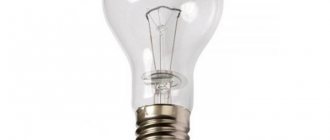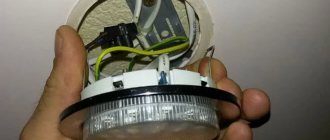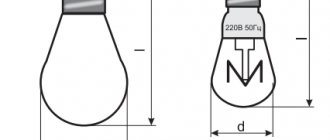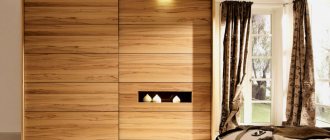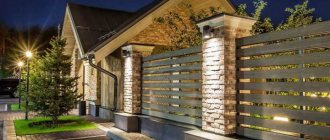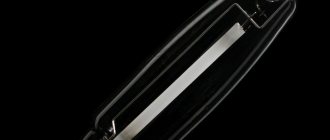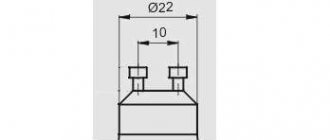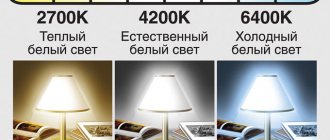Buying the right type of lamp for a lamp in a store is not such an easy task. What do you want from quality lighting first of all:
- comfort for the eyes
- energy savings
- harmless use
Type of base
Before purchasing a light bulb, it is first important to determine the required type of base. Most household lighting fixtures use two types of threaded base:
- base E-14 or minion
- base E-27
They differ accordingly in diameter. The numbers in the designation indicate its size in millimeters. That is, E-14=14mm, E-27=27mm. There are also adapters for lamps from one lamp to another.
If the lampshades of the chandelier are small, or the lamp has some specific features, then a pin base is used.
It is designated by the letter G and a number that indicates the distance in millimeters between the pins. The most common are:
- G5.3 - which are simply inserted into the luminaire connector
- GU10 - first inserted and then turned a quarter turn
The spotlights use the R7S base. It can be used for both halogen and LED lamps.
The lamp power is selected based on the limitations of the lighting fixture in which it will be installed. Information about the type of base and the power limitation of the lamp used can be seen:
- on the box of the purchased lamp
- on the lampshade already installed
- or on the light bulb itself
Why is it important to consider the type of lamps and their characteristics
Modern humanity uses electric lighting regularly. The only exceptions are the most remote, wild corners of the planet, where the way of life is not far removed from tribal relations, as well as specialized settlements for tourists, stylized as antiques.
Artificial light, research shows, can be quite disturbing. Therefore, to feel comfortable, you need to choose the right light sources. This is especially important in the following cases:
- when lamps are purchased for a room with suspended ceilings or other fire-hazardous structures;
- when choosing lighting fixtures for bedrooms, children's rooms, kitchens, workshops. That is, those rooms in which proper lighting plays a huge role;
- if you need to adhere to a certain color shade in the lighting.
In addition, the right choice of lamps helps to save energy and reduces the amount of electricity bills.
The right lamp is no less important for the interior and well-being of household members than an interesting modern lamp or a luxurious sconce in the national style.
Flask shape
The next thing you need to pay attention to is the shape and size of the flask.
A flask with a threaded base may have:
- pear shape
- ball of different diameters
- or the shape of a candle for narrow chandelier shades and sconces
Pear-shaped ones are designated by the nomenclature - A55, A60; ball ones - with the letter G. The numbers correspond to the diameter. Candles are marked with the Latin letter - C.
A bulb with a pin base has the shape:
- small capsule
- or flat reflector
Halogen devices
These artificial light sources include gas-filled incandescent lamps. In them, halogen substances - iodine, bromine, chlorine, etc. - are added to the inert gas filling the flask. The metal evaporates from the hot filament and settles on the walls of the flask. Wherein:
- the thickness of the thread decreases;
- the metal on the glass of the bulb reduces its transparency - the luminous flux decreases.
The evaporated metal atoms of the halogen substances bind into “oxides”. When they fall on the hot metal of the filament body, they disintegrate and the metal settles on the surface of the filament. As a result, the lifespan of the device increases by 3-4 times, and the hue of the glow “whitens.”
Halogen incandescent lamp with double bulb and Edison E27 threaded base.
Inside the pear-shaped glass bulb, a capsule halogen small-sized lamp is placed on the fittings of a conventional incandescent lamp.
Automotive halogen incandescent lamp in a tubular bulb with a soffit base. It ensures operation in conditions of vibration and low impact impacts.
Halogen model with reflector and protective glass in an MR type bulb with a GU 5.3 pin base.
G – glass – translation from English – glass, U – design option for the base, 5.3 – distance between the axes of the pins in millimeters.
Lighting standards
Lighting brightness is an individual concept. However, it is generally accepted that for every 10 m2 with a ceiling height of 2.7 m, a minimum illumination equivalent of 100 W is required.
Illumination is measured in lux. What is this unit? In simple words, when 1 lumen illuminates 1 m2 of room area, then this is 1 lux.
The standards differ for different rooms.
Illumination depends on many parameters:
- from distance to light source
- colors of surrounding walls
- reflection of light flux from foreign objects
Illumination can be measured very easily using standard smartphones. All you need to do is download and install a special program. For example – Luxmeter (link)
True, such programs and phone cameras usually lie compared to professional light meters. But for household needs, this is more than enough.
Characteristics
Incandescent lamps are characterized by the following values:
- Power, W). The range of this indicator is impressive in scope - from 25 to 1000 W. The “glow strength” is selected based on the calculation of the room illumination. For domestic needs, 25-150 W is enough, and for others – more powerful;
- voltage (V). Types of lamps operating on voltages of 220 V and 380 V are available. There are also lighting sources operating on reduced voltage;
- luminous efficiency (Lm/W). The higher this indicator, the brighter the light source will burn. For this product it is in the range of 9-19 Lm/W;
- type and size of the base. Depending on the type of installation, the base can be threaded and one- or two-pin pin. The size of the base has three standards - E14, E27 and E40 (the most popular). The numbers indicate the diameter in millimeters;
- operational resource. Under acceptable conditions, an incandescent lamp can last up to 1000 hours.
The types and characteristics of incandescent lamps are quite diverse. This determines their popularity and prevalence in various industrial and household areas.
Lamp sockets (types, types, explanation).
Incandescent and halogen bulbs
The classic and most inexpensive solution for lighting an apartment is the familiar incandescent lamp, or its halogen version. Depending on the type of base, this is the most affordable purchase. Incandescent and halogen bulbs provide comfortable, warm light without flickering and do not emit any harmful substances.
However, it is not recommended to touch the bulb with your hands for halogen lamps. Therefore, they must come packaged in a separate bag.
When a halogen light is lit, it gets very hot. And if you touch its bulb with greasy hands, residual stress will form on it. As a result of this, the spiral in it will burn out much faster, thereby reducing its service life.
In addition, they are very sensitive to power surges and often burn out because of this. Therefore, they are installed together with soft start devices or connected via dimmers.
Halogen lamps are mostly manufactured to operate from a single-phase network with a voltage of 220-230 Volts. But there are also low-voltage 12-volt ones that require connection via a transformer for the appropriate type of lamp.
A halogen lamp shines brighter than a regular one, by about 30%, but consumes the same power. This is achieved due to the fact that it contains a mixture of inert gases inside.
In addition, during operation, particles of tungsten elements are returned back to the filament. In a conventional lamp, gradual evaporation occurs over time and these particles settle on the bulb. The light bulb dims and works half as hard as a halogen light bulb.
Choosing the right light source
When choosing lamps for lighting, be guided by operating conditions, area and purpose of the room (or open area).
HID lamps are not used for home lighting. They gradually die off due to the presence of mercury in the composition. Sodium lamps for street lighting are often replaced with LED lamps.
For household lighting, incandescent, halogen, fluorescent and LED lamps are most suitable. To illuminate rooms where the light is on rarely and little by little, it is quite possible to use incandescent lamps. They are also indispensable for lighting steam rooms (Led and CFL in them will not withstand high temperatures). A halogen lamp is also suitable for a steam room.
LED light sources are suitable for constantly illuminated rooms. At the same time, pay attention to the color temperature: for rest rooms - warm colors, for work rooms - neutral or cold.
CFLs should not be used in the heat or at temperatures below 5⁰C.
LED strips and flexible neon are suitable for decorative lighting and advertising.
Spot lighting can be easily organized using halogen or LED spots.
When lighting damp rooms (cellar, basement), it is better to use low-voltage lighting.
Color rendering and luminous flux
The advantage of conventional incandescent lamps is a good color rendering index. What it is? Roughly speaking, this is an indicator of how much light close to solar light is contained in the scattered flux.
For example, when sodium and mercury lamps illuminate the streets at night, it is not entirely clear what color people’s cars and clothes are. Since these sources have a poor color rendering index - around 30 or 40%. If we take an incandescent lamp, then the index is already more than 90%.
Currently, the sale and production of incandescent lamps with a power exceeding 100W is not permitted in retail stores. This is done for reasons of preserving natural resources and saving energy.
Some people still mistakenly choose lamps based on the power labels on the packaging. Remember that this number does not indicate how bright it shines, but only how much electricity it consumes from the network.
The main indicator here is luminous flux, which is measured in lumens. This is what you need to pay attention to when choosing.
Since many of us previously focused on the popular power of 40-60-100W, manufacturers for modern energy-saving lamps always indicate on the packaging or in catalogs that their power corresponds to the power of a simple incandescent light bulb. This is done solely for the convenience of your choice.
Infrared devices
These types of lamps are incandescent lamps, in which their main disadvantage - a high level of thermal radiation - has been turned into an advantage. The current is selected at such a value that the light radiation is less. In it, the filament is heated to a temperature close to red heat. The main flow of its energy is infrared radiation. It is rightly called thermal. Externally they look like this.
Infrared lamp with a glass bulb and Edison socket, size E27.
Luminescent - energy saving
Fluorescent lamps have a good level of energy savings. Inside them there is a tube from which the flask is made, coated with phosphor powder. This provides a glow 5 times brighter than incandescent lamps at the same power.
Luminescent ones are not very environmentally friendly due to the coating of mercury and phosphor inside. Therefore, they require careful disposal through certain organizations and containers for receiving used light bulbs and batteries.
They are also subject to flicker. This is easy to check; just look at their glow on the display through your smartphone’s camera. It is for this reason that it is not advisable to place such light bulbs in residential areas where you are constantly present.
Disadvantages of low voltage lamps
The disadvantages of lamps that operate on low voltage include the following:
- Low voltage lamps cannot operate directly from a 220 V network, so a transformer must be installed during installation. This device is not insured against breakdown, regardless of the performance of the lamps. Thus, the entire electrical circuit becomes more complex and prone to malfunctions.
- The need for electric current is higher than for lamps from 220 V. The difference will be noticeable if the connected lamps in the room are located at different distances, that is, the farther the lighting device is, the weaker it will work.
LED
LED lamps and lamps of various shapes and designs are widely used in various spheres of life.
Their advantages:
- resistance to temperature overloads
- negligible effect on voltage drops
- ease of assembly and use
- high reliability under mechanical loads. There is minimal risk that it will break if dropped.
LED lamps heat up very little during operation and therefore have a lightweight plastic body. Thanks to this, they can be used where others cannot be installed. For example, in suspended ceilings.
Energy savings from LEDs are greater than from fluorescent and energy-saving ones. They consume approximately 8-10 times less than incandescent lamps.
If we roughly take the average parameters for power and luminous flux, we can obtain the following data:
These results are approximate and in reality will always differ, since much directly depends on the voltage level, manufacturer brand and many other parameters.
For example, in the USA, in one fire station, an ordinary incandescent light bulb, which is already more than 100 years old, is still burning. There was even a special website created where you can watch her online through a web camera.
Everyone is waiting for it to burn down in order to record this historical moment. You can view it here.
Incandescent lamps
Lamps with E27 and E14 socket
The advantages of modern incandescent lamps (LON) include:
- simplicity of design and low price of the materials used, which in mass production ensure their low cost;
- the ability to create products for different operating voltages - from several volts to hundreds of volts;
- a continuous spectrum of luminescence, similar to the spectrum of the Sun - this is the spectrum of thermal and visible radiation of a metal heated to the point of glow, the name of incandescent lamps is associated with this;
- gas-filled, including halogen incandescent lamps, have a service life of 2-3 thousand to tens of thousands of hours;
- Brightness adjustment, i.e. dimming, is carried out by fairly simple means - rheostats, thyristor and triac dimmers.
The nominal service life of 1,000 hours for LON - general-purpose light bulbs, was established in 1930 by agreement of the world's main manufacturers of that period. Violators of this deadline have been and continue to be punished by international sanctions.
The simplest classification of incandescent lamps:
- LON – general purpose lamps, used everywhere in everyday life and in production;
- halogen incandescent lamps - halogen substances are added to the inert gas;
- incandescent light bulbs for local lighting are characterized by a safe low operating voltage of 12, 24, 36 or 48 V, a short filament and resistance to mechanical stress.
From the video you will learn how incandescent lamps are produced
More than a century of development of incandescent lamps has shown that they can be used in any field of human activity - from household to special lighting:
- in transport - in cars, on trains, ships, airplanes;
- in production - for lighting premises, for obtaining absolutely clean heat without pollutants - in medicine, industry for the production of semiconductor devices, in livestock and poultry farming - for heating young animals, and much more. etc.
Light flow
LED and energy-saving lamps have the ability to produce different colors of light output.
- warm yellow
In this case, it will indicate the value 2700-3500 Kelvin. This is the so-called color temperature. This light is similar to simple incandescent light bulbs. Yellow is the most comfortable for the eyes and cozy for life.
- day white
The lamp indicates 3500-4500 Kelvin. This light is good where correct color rendition is needed - a desktop, applying makeup, artistic work.
- bluish-cold 6400 Kelvin and above
This light would be appropriate in a bathroom or utility room.
In order not to look for incomprehensible numbers and quickly distinguish the amount of luminous flux, manufacturers often put visual color codes on the packaging:
- blue frame – cold light
- yellow – warm
The optimal choice for different rooms
Experts involved in interior design advise using compact LEDs or low-voltage miniature halogens for suspended or suspended ceilings.
It is also important to take into account that the power of the lamps must correspond to that of the lamp or be lower. Violation of this rule can lead to serious consequences
Almost all types of lighting fixtures can be used in chandeliers and other hanging structures. If the lamps are made of fusible materials, it is better to use LED or fluorescent sources.
The best options for sconces are small halogens, fluorescent models or traditional incandescent lamps. Often in such devices decorative modifications are used with flasks in the form of drops, flames, and balls.
For illumination, small LED bulbs or compact halogen bulbs powered by a transformer are suitable.
Living rooms usually use a combination of several lighting fixtures. A ceiling or hanging chandelier is complemented by a sconce, a floor lamp, a decorative table lamp, as well as built-in lamps.
It is advisable to equip the main device with a dimmer, which will allow you to dim its intensity.
The table contains the values of the illumination level required by SNiP 05/23/2010. Indicators are given in lumens
Floodlights for outdoor lighting predominantly use linear halogen devices. Lighting decoration of a yard or area is also possible using LEDs, including those powered by solar panels, or powerful incandescent lamps.
In the basement and cellar, where there is usually a high level of humidity, it is necessary to use lamps with waterproofing and a completely closed socket.
To prevent short circuits, it is advisable to use a step-down transformer. In this case, one or two 12-volt LED sources are best suited as a lighting device.
Similar requirements apply to lighting devices in bathrooms. Typically, halogen/LED models as well as incandescent lamps are used to illuminate the space.
To equip a schoolchild's workplace, a flexible table lamp is usually used, which allows you to change the direction of the light beam. Typically, a traditional 60-volt incandescent device with a clear or frosted bulb is inserted into it.
If there is a lack of light, it is advisable to also add lighting with built-in halogen lamps.
The choice of light source for greenhouses requires special attention. As research by scientists has shown, the red and blue regions of the spectrum are especially useful for plants. The first has a powerful effect during the flowering and fruiting period of vegetables, the second contributes to their active growth and development.
The easiest way to reproduce this light range is with the help of special LED lamps. You can make them yourself or buy them in a store.
A table that allows you to easily calculate the required power of different types of lamps. With its help you can easily create the lighting level required by the current SNiP
When choosing a model, you should pay attention to the shade of the emitted rays. Typically, this factor depends on user preferences.
Nevertheless, designers recommend choosing “cozy” warm light for the living room or bedroom, while coolish light for the office or office space.
When determining the power of a lamp, you need to take into account not only the area of the room for which it is intended, but also the degree of natural lighting level: in darkened spaces with windows to the north, more powerful devices are installed.
Influences the choice and color scheme of the interior: rooms with dark walls require more powerful lamps.
Modern energy-saving lamps: basic scientific developments for home lighting
Since heating filaments requires large amounts of electricity, in contrast to them, light sources are produced that require significantly less energy to operate. They began to be called energy-saving.
These include lamps using:
- glow energy of a gas discharge (gas discharge);
- light emission when current passes through a semiconductor junction - LED.
Gas discharge lamps: 2 types of fluorescent designs
In technical rooms you can still find long tubular or curved fluorescent lamps.
Inside a sealed glass bulb coated with a phosphor, there are electrode filaments. They work in a gas environment with mercury vapor.
To start a gas discharge, ballasts are used, which include a choke and a starter that work in concert.
The process of starting a discharge, performed in four stages, is described in more detail at the beginning of a separate article about repairing energy-saving CFLs. Read it there if you are interested.
Due to the current passing through the inductor, such fluorescent lamps create a slight noise, which is not very good for residential premises. But lighting from them is cheaper than from Ilyich bulbs. Therefore, they are most often used in production.
Compact energy-saving lamp: how it works
Its design is similar in principle to the previous model, with the exception of several modern modifications:
- the glass flask is made in the shape of a complex spiral;
- The ballasts are made on an electronic base (called electronic ballasts) and are housed in a single housing with the lamp.
Its components are as follows.
The electronic ballast includes blocks of a network rectifier with a filter and a high-frequency converter.
For a compact fluorescent light bulb (CFL), like its predecessor, the most common malfunction is the filament burning out. The functionality of a damaged lamp can be restored if a two-watt resistance of 4-5 Ohms is soldered parallel to its contacts.
Conventional and compact fluorescent lamps require careful handling and industrial disposal due to the presence of mercury vapor and a phosphor layer.
Another disadvantage of this design is the flickering effect, which has a harmful effect on human vision. Therefore, when choosing such lamps, you should pay attention to the stability of lighting.
You can check this mode on the screen of a digital camera, which is now built into every mobile phone.
Flickering of light is the main reason why these sources are not recommended for use in permanent living rooms, despite their lower energy consumption.
Main types of LED lamps for household use
Any LED lamp consists of chains of LEDs, which are specially connected to the power driver.
Semiconductor elements are assembled according to a specific circuit and form a single SMD LED.
Depending on their type, different types of LED lamps are formed:
- pear is the most typical shape for installation in large lampshades with a total height of up to 126 mm and a width of 60;
- ball - for small round lampshades;
- a candle installed in narrow or flat lamps;
- a candle in the wind is a decorative lamp that creates beautiful lighting effects with iridescent color shades;
- reflector providing directional light flux;
- corn, distributing light to the sides, resembling the shape of an ear of corn.
They use sockets that are compatible with lighting fixture sockets and markings that allow you to indicate the diameter size of the socket in millimeters.
If operating conditions are violated or incorrectly connected, LED bulbs can cause blinking that is harmful to the eyes. It is not difficult for a home craftsman to identify and eliminate it on his own.
Filament lamp: features and benefits
Filament is the English word for thread.
The initial design was developed by specialists from Japan. They tried to bring the appearance of the LED source closer to a conventional incandescent light bulb, which evenly distributes light in all directions.
For it, rather small LEDs are used, arranged in thin ribbons - threads from a technical sapphire substrate. Their usual number is 28 LEDs per element.
The entire thread is evenly coated with a layer of phosphor on top.
The created filament thread is an ordinary rod of a certain length that consumes 1 watt of electricity. It is easy to count their number and determine the power of the light bulb based on this external sign.
The current on the Filament filament comes from a power supply with an electronic stabilizer. It is mounted inside the E27 base or in a special plastic insert near it. The electronic board has certain dimensions that simply do not fit inside an E14 base or smaller.
Considering the power applied to one filament of 1 watt and the operation of the power stabilizer, the current flowing through the series ice chain cannot heat the LEDs above 60 degrees Celsius. This has a beneficial effect on their operation.
Filament threads are spaced apart inside a glass flask filled with gas: helium. It further improves the heat transfer from the LEDs to the external environment through the glass bulb.
The power driver circuit is also selected according to the characteristics of minimal heat generation, which eliminates overheating of the entire light bulb structure.
The modern Filament lamp has not only an original design that attracts human attention, but also improved light characteristics combined with increased reliability during operation.
This material is well complemented by a video from the owner of Radio Amateur TV, which reveals the topic of household lighting sources.

